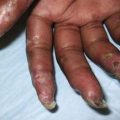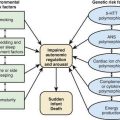Chapter 185 Neisseria gonorrhoeae (Gonococcus)
Clinical Manifestations
Gonorrhea is manifested by a spectrum of clinical presentations from asymptomatic carriage, to the characteristic localized urogenital infections, to disseminated systemic infection (Chapter 114).
Uncomplicated Gonorrhea
Gonococcal ophthalmitis may be unilateral or bilateral and may occur in any age group after inoculation of the eye with infected secretions. Ophthalmia neonatorum due to N. gonorrhoeae usually appears from 1 to 4 days after birth (Chapter 618). Ocular infection in older patients results from inoculation or autoinoculation from a genital site. The infection begins with mild inflammation and a serosanguineous discharge. Within 24 hr, the discharge becomes thick and purulent, and tense edema of the eyelids with marked chemosis occurs. If the disease is not treated promptly, corneal ulceration, rupture, and blindness may follow.
Treatment
All patients who are presumed or proven to have gonorrhea should be evaluated for concurrent syphilis, hepatitis B, HIV, and C. trachomatis infection. The incidence of Chlamydia co-infection is 15-25% among males and 35-50% among females. Patients beyond the neonatal period should be treated presumptively for C. trachomatis infection unless a negative chlamydial NAAT result is documented at the time treatment is initiated for gonorrhea. However, if chlamydial test results are not available or if a non-NAAT result is negative for Chlamydia, patients should be treated for both gonorrhea and Chlamydia infection (Chapter 218.2). Sexual partners exposed in the preceding 60 days should be examined, culture specimens should be collected, and presumptive treatment should be started.
Prevention
Gonococcal ophthalmia neonatorum can be prevented by instilling 2 drops of a 1% solution of silver nitrate into each conjunctival sac shortly after birth (Chapter 618). Erythromycin (0.5%) or tetracycline (1%) ophthalmic ointment may also be used.
Centers for Disease Control and Prevention. Updated recommended treatment regimens for gonococcal infections and associated conditions—United States, April, 2007. MMWR Morbid Mortal Wkly Rep. 2007;56:332-336.
Centers for Disease Control and Prevention. 2006 sexually transmitted diseases treatment guidelines for treatment of sexually transmitted diseases. MMWR Morbid Mortal Wkly Rep. 2006;55:1-94.
Cohen MS, Sparling PF. Mucosal infection with Neisseria gonorrhoeae, bacterial adaptation and mucosal defenses. J Clin Invest. 1992;89:1699-1705.
Fox KK, Knapp JS, Holmes KK, et al. Antimicrobial resistance in Neisseria gonorrhoeae in the United States, 1988–1994: the emergence of decreased susceptibility to the fluoroquinolones. J Infect Dis. 1997;175:1396-1403.
Hook EW, Holmes KK. Gonococcal infections. Ann Intern Med. 1985;102:229-243.
Mathews C, Coetzee D. Partner notification for the control of STIs. BMJ. 2007;334:323.
O’Brien JP, Goldenberg DL, Rice PA. Disseminated gonococcal infection: a prospective analysis of 49 patients and a review of pathophysiology and immune mechanisms. Medicine (Baltimore). 1983;62:395-406.
Plummer FA, Chubb H, Simonsen JN, et al. Antibody to Rmp (outer membrane protein 3) increases susceptibility to gonococcal infection. J Clin Invest. 1993;91:339-343.
Rice PA, McQuillen DP, Gulati S, et al. Serum resistance of Neisseria gonorrhoeae: does it thwart the inflammatory response and facilitate the transmission of infection? Ann NY Acad Sci. 1994;730:7-14.
Tapsall JW. Antibiotic resistance in Neisseria gonorrhoeae. Clin Infect Dis. 2005;41(Suppl 4):S263-S268.







